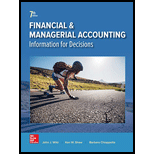
Concept explainers
1.
To prepare: Bank reconciliation of S Company as at December 31, 2017.
1.
Explanation of Solution
While bank reconciliation required adjustments should be made to match the balances.
Bank reconciliation of S Company as follows:
|
S Company |
|||
|
Bank Reconciliation |
|||
|
December 31, 2017 |
|||
|
Particulars |
Amount ($) |
Particulars |
Amount ($) |
|
Balance as per bank statement |
46,822.40 |
Balance as per book of account |
32,878.30 |
|
Add: |
Add: |
||
|
Deposit made on Dec 31 |
9,583.10 |
Collection of note receivable |
18,980 |
|
Less: |
Error underlying check No.1267 |
9 |
|
|
Outstanding check No.1242 |
410 |
Less: |
|
|
Outstanding check No.1273 |
4,589.30 |
Service charges levied by bank |
99 |
|
Outstanding check No.1282 |
400 |
NSF check |
762.50 |
|
Adjusted balance of bank |
51,005.80 |
Adjusted balance of book |
51,005.80 |
2.
To prepare: Journal entries to bring the company’s book balance of cash into conformity with the reconciled cash balance as of December 31, 2017.
2.
Explanation of Solution
|
Date |
Account Title and Explanation |
Post ref |
Debit ($) |
Credit ($) |
|
Dec.31,2017 |
Cash |
18,980 |
||
|
Expenses for collection |
20 |
|||
|
Notes receivable |
19000 |
|||
|
|
(To record note receivable collection) |
- Here, note receivable is of $19,000 and collection fee of note receivable accounts for $20. Thus cash received against this is $18,980 ($19,000-$20)
- Cash has come into the business which shows increment in cash and when cash increases it gets debited because cash is an asset.
- On the other hand note receivable is also a form of asset which decreases and gets credited. Thus note receivable account gets credited.
Service charges levied by the bank for NSF check.
|
Date |
Account Title and Explanation |
Post ref |
Debit ($) |
Credit ($) |
|
Dec.31,2017 |
|
762.50 |
||
|
Cash |
762.50 |
|||
|
|
(To record charges levied by the bank for NSF check in addition to fees ) |
- In such case, service charges $762.50 deducted by the bank which pertains to NSF check.
- Since Cash and Accounts Receivable are asset account, which get debited when increases and credited when decreases. Cash has paid, so it gets credited and accounts receivable has increased so it gets debited.
Bank charged for check printing.
|
Date |
Account Title and Explanation |
Post ref |
Debit ($) |
Credit ($) |
|
Dec 31,2017 |
Miscellaneous Expenses |
99 |
||
|
Cash |
99 |
|||
|
|
(To record charges levied by the bank to print checks) |
- All expenses are debited when it increases. Thus check printing is also an expense and debited under Miscellaneous Expenses account.
- Whereas cash has paid out of the business and same has been decreased. Thus Cash account gets credited.
- All expenses are credited when it decreases. Thus, expense for office supplies is required to be reduced since it has been recorded in excess. Hence, same is decreased and credited.
- Whereas cash was understated by mistake and need to be increased. Thus, Cash account gets debited.
Entry related to office supplies.
|
Date |
Account Title and Explanation |
Post ref |
Debit ($) |
Credit ($) |
|
Dec.31,2017 |
Cash |
9 |
||
|
Expense for office supplies |
9 |
|||
|
|
(To record correction of error in entry related to check no.1267) |
3.
To explain: Nature of communications conveyed by the bank when bank sends the depositor (a) a debit memorandum and (b) a credit memorandum.
3.
Explanation of Solution
(a)
Bank sends a debit memorandum to the depositor to indicate that the depositor’s account has been debited by the bank. Since depositor’s account is considered as liability of the bank and his/her bank account has decreased.
(b)
On the other hand bank sends credit memorandum to the depositor to indicate that depositor’ account has been credited by the bank and due to this account balance of depositor has also increased.
Thus, debit memorandum and credit memorandum are ways of communication between the bank and its customers.
Want to see more full solutions like this?
Chapter 6 Solutions
Financial and Managerial Accounting
- Dylan Manufacturing had an estimated 90,000 direct labor hours, $360,000 manufacturing overhead, and 30,000 machine hours. The actual results were 91,200 direct labor hours, 32,500 machine hours, and $415,000 manufacturing overhead. Overhead is applied based on machine hours. Calculate the predetermined overhead rate. Helparrow_forwardHELParrow_forwardHow much total overhead cost will be allocated?arrow_forward

 AccountingAccountingISBN:9781337272094Author:WARREN, Carl S., Reeve, James M., Duchac, Jonathan E.Publisher:Cengage Learning,
AccountingAccountingISBN:9781337272094Author:WARREN, Carl S., Reeve, James M., Duchac, Jonathan E.Publisher:Cengage Learning, Accounting Information SystemsAccountingISBN:9781337619202Author:Hall, James A.Publisher:Cengage Learning,
Accounting Information SystemsAccountingISBN:9781337619202Author:Hall, James A.Publisher:Cengage Learning, Horngren's Cost Accounting: A Managerial Emphasis...AccountingISBN:9780134475585Author:Srikant M. Datar, Madhav V. RajanPublisher:PEARSON
Horngren's Cost Accounting: A Managerial Emphasis...AccountingISBN:9780134475585Author:Srikant M. Datar, Madhav V. RajanPublisher:PEARSON Intermediate AccountingAccountingISBN:9781259722660Author:J. David Spiceland, Mark W. Nelson, Wayne M ThomasPublisher:McGraw-Hill Education
Intermediate AccountingAccountingISBN:9781259722660Author:J. David Spiceland, Mark W. Nelson, Wayne M ThomasPublisher:McGraw-Hill Education Financial and Managerial AccountingAccountingISBN:9781259726705Author:John J Wild, Ken W. Shaw, Barbara Chiappetta Fundamental Accounting PrinciplesPublisher:McGraw-Hill Education
Financial and Managerial AccountingAccountingISBN:9781259726705Author:John J Wild, Ken W. Shaw, Barbara Chiappetta Fundamental Accounting PrinciplesPublisher:McGraw-Hill Education





